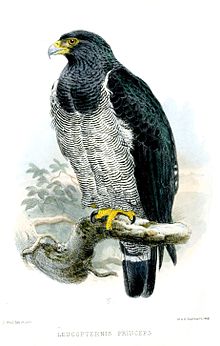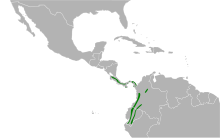
The Accipitridae is one of the three families within the order Accipitriformes, and is a family of small to large birds with strongly hooked bills and variable morphology based on diet. They feed on a range of prey items from insects to medium-sized mammals, with a number feeding on carrion and a few feeding on fruit. The Accipitridae have a cosmopolitan distribution, being found on all the world's continents and a number of oceanic island groups. Some species are migratory.

The white hawk is a bird of prey breeding in the tropical New World of the family Accipitridae. Though it is commonly placed in the subfamily Buteoninae, the validity of this group is doubtful and currently under review.

The ornate hawk-eagle is a fairly large bird of prey from the tropical Americas. Formerly, some authorities referred to this species as the crested hawk-eagle, a name that may cause some confusion as it is more commonly used for an Asian eagle species. Like all eagles, it is in the family Accipitridae. This species has a feathered tarsus that marks it as a member of the Aquilinae or booted eagle subfamily. This species is notable for the vivid colors and bold markings of adults, which differ considerably from the far more whitish plumage of the juvenile bird. The ornate hawk-eagle ranges from central Mexico south through much of Central America and in a somewhat spotty but broad overall range into South America, including in the west apart from the Andes and broadly on the Atlantic side especially Brazil down to as far as Southeast Brazil and northern Argentina. This species is found largely in primary forests with tall trees, although can be found in many forest types. The ornate hawk-eagle female lays almost always a single egg and the species has a fairly prolonged breeding cycle like many tropical raptors, especially due to a lengthy post-fledging stage on which juveniles are dependent on their parents. It is a diversified and exceptionally powerful predator which takes a range of prey, usually various medium-to-large-sized birds and small-to-medium-sized mammals as well as occasional reptiles. Like many forest-dependent raptors, especially those in the tropical and subtropical regions, this species is likely under the pressing threat of deforestation. The decline of forest habitat in this species range, especially the Amazon rainforest, led the IUCN to uplist the ornate hawk-eagle as Near Threatened in 2016.

The collared plover is a small shorebird in the plover family, Charadriidae. It lives along coasts and riverbanks of the tropical to temperate Americas, from central Mexico south to Chile and Argentina.

The black-chested buzzard-eagle is a bird of prey of the hawk and eagle family (Accipitridae). It lives in open regions of South America. This species is also known as the black buzzard-eagle, grey buzzard-eagle or analogously with "eagle" or "eagle-buzzard" replacing "buzzard-eagle", or as the Chilean blue eagle. It is sometimes placed in the genus Buteo.

The tiny hawk is a small diurnal bird of prey found in or near forests, primarily humid, throughout much of the Neotropics. It is primarily a bird-eater, and is known to prey on hummingbirds.
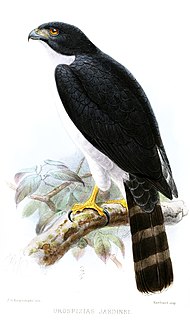
The grey-bellied hawk or grey-bellied goshawk is a fairly large and rare species of forest-dwelling South American bird of prey in the family Accipitridae.

The black-collared hawk is a species of bird of prey in the family Accipitridae. It is monotypic within the genus Busarellus. It has a widespread range of presence, from western Mexico to Uruguay. Its natural habitats are subtropical or tropical moist lowland forests, subtropical or tropical swamps, and swamps.

Buteogallus is a genus of bird of prey in the family Accipitridae. All members of this genus are essentially neotropical, but the distribution of a single species extends slightly into the extreme southwestern United States. Many of the species are fond of large crustaceans and even patrol long stretches of shore or riverbank on foot where such prey abounds, but some have a rather different lifestyle. Unlike many other genera of raptor, some members are referred to as "hawks", and others as "eagles".
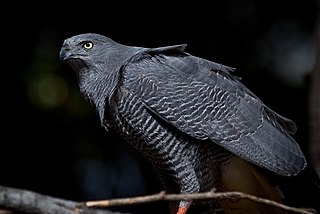
The crane hawk is a species of bird of prey in the family Accipitridae. It is monotypic within the genus Geranospiza.
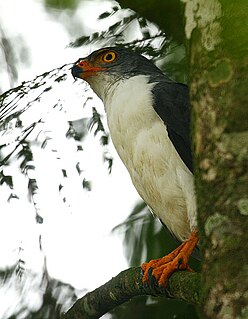
Leucopternis is a Neotropical genus of birds of prey in the family Accipitridae. They are associated with tropical forest, and are uncommon or rare. Their plumage is largely black or gray above and white below, and they have distinctive orange ceres.

The black-faced hawk is a species of bird of prey in the family Accipitridae. This low-density species has traditionally been believed to be restricted to Amazon Basin north of the Amazon River, but there are several records south of this river, in, for example, the Brazilian states of Pará and Acre, and southeastern Peru. It is closely related to the white-browed hawk and individuals showing a level of intermediacy between the two species are known, suggesting that they rarely hybridize

The mantled hawk is a South American species of bird of prey in the family Accipitridae.

The semiplumbeous hawk is a species of bird of prey in the family Accipitridae. It is found in Colombia, Costa Rica, Ecuador, Honduras, and Panama. Its natural habitat is subtropical or tropical moist lowland forests.
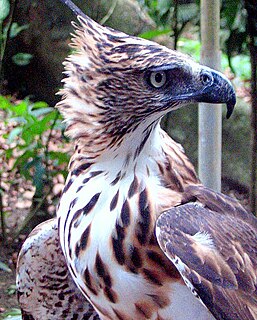
The Philippine hawk-eagle or north Philippine hawk-eagle, earlier treated under Spizaetus, is a species of bird of prey in the family Accipitridae. Many taxonomists consider the Pinsker's hawk-eagle, a former subspecies, raised to full species status. It is endemic to the Philippines. Its natural habitat is tropical moist lowland forests. It is threatened by habitat loss and trapping.

The black-and-white hawk-eagle is a bird of prey species in the eagle and hawk family (Accipitridae). It is found throughout a large part of tropical America, from southern Mexico to northern Argentina.
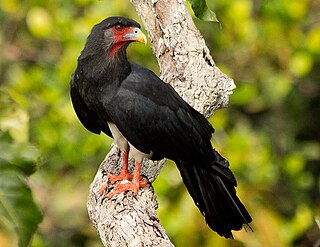
The red-throated caracara is a social species of bird of prey in the family Falconidae. It is placed in the monotypic genus Ibycter, or sometimes united in Daptrius with the black caracara. Unique among caracaras, it mainly feeds on the larvae of bees and wasps, but also takes the adult insects and fruits and berries.

The Philippine falconet is a species of bird of prey in the family Falconidae, genus Microhierax. It is endemic to the lowland forests of Philippines, and can often be seen near open forest edges hunting flying insects. Philippine falconets nest in woodpecker holes of dead trees, and can be seen fairly commonly within their suitable habitats. Although the Philippine falconet population is declining due to habitat loss, it is still evaluated as "Least Concern" globally.

The black-tipped cotinga, also known as the white cotinga, is a species of bird in the family Cotingidae. It is found in the Chocó region, from southeastern Panama to northwestern Ecuador ; its natural habitat is subtropical or tropical moist lowland forests. The male, being white, is conspicuous, but in general it is an uncommon species.

The gray hawk or Mexican goshawk is a smallish raptor found in open country and forest edges. It is sometimes placed in the genus Asturina as Asturina plagiata. The species was split by the American Ornithological Society (AOU) from the gray-lined hawk. The gray hawk is found from Costa Rica north into the southwestern United States.
